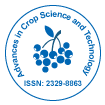当社グループは 3,000 以上の世界的なカンファレンスシリーズ 米国、ヨーロッパ、世界中で毎年イベントが開催されます。 1,000 のより科学的な学会からの支援を受けたアジア および 700 以上の オープン アクセスを発行ジャーナルには 50,000 人以上の著名人が掲載されており、科学者が編集委員として名高い
。オープンアクセスジャーナルはより多くの読者と引用を獲得
700 ジャーナル と 15,000,000 人の読者 各ジャーナルは 25,000 人以上の読者を獲得
インデックス付き
- CAS ソース インデックス (CASSI)
- 索引コペルニクス
- Google スカラー
- シェルパ・ロミオ
- 環境研究へのオンライン アクセス (OARE)
- Jゲートを開く
- アカデミックキー
- ジャーナル目次
- Global Online Research in Agriculture (AGORA) へのアクセス
- レフシーク
- ハムダード大学
- エブスコ アリゾナ州
- OCLC-WorldCat
- 学者の舵取り
- SWBオンラインカタログ
- パブロン
- ユーロパブ
役立つリンク
オープンアクセスジャーナル
このページをシェアする
抽象的な
Correlation Analysis for Agronomic and Fiber Quality Traits of Upland Cotton (Gossypium hirsutum L.) Genotypes under Irrigated Condition of Ethiopia
Merdasa Balcha, Arkebe G Egziabher, Bedane Gudeta, Donis Gurmessa, Samuel Damtew, Alehegn Workie and Mekashaw Arega
Cotton breeders have faced the challenge of simultaneously improving yield and fiber quality traits. However, seed cotton yield must at least be maintained when improving fiber quality for a cultivar to remain competitive. The research work pertaining to the study of mean performance and correlation for agronomic and fiber quality traits during 2016 to 2018 at Werer Agricultural Research Center and Nasa-farm using RCBD with three replication among 12 cotton genotypes and 3 cotton checks variety. Analysis of variance manifested highly significant differences among the genotypes for all agronomic and fiber quality traits except average bolls weight and plant height. Genetic potential of fifteen cotton genotypes for different agronomic and quality traits were recorded. Highest mean value for seed cotton yield were registered for genotypes Chamo Farm no 1A1-1DP-90 F1#307(5.28 t ha-1) followed by genotypes Farm no Ago1 DP-90 F1#337(5.22 t ha-1) and Weyto Farm no M1 DP-90 F1#376(5.05 t ha-1) with good ginning outturn, fiber length and fiber strength. Phenotypic correlation of seed cotton yield and lint yield with other traits was found positive for majority of traits except fiber strength and fiber length that negatively correlated. Yield traits showed positive and significant genotypic correlations to ginning outturn and micronaire. It was also evident that the higher magnitude of genotypic correlation coefficients over phenotypic correlation coefficients of seed cotton yield with ginning outturn and micronaire as the result suggested that indirect selection of agronomic traits may be used to increase seed cotton yield.

 English
English  Spanish
Spanish  Chinese
Chinese  Russian
Russian  German
German  French
French  Portuguese
Portuguese  Hindi
Hindi